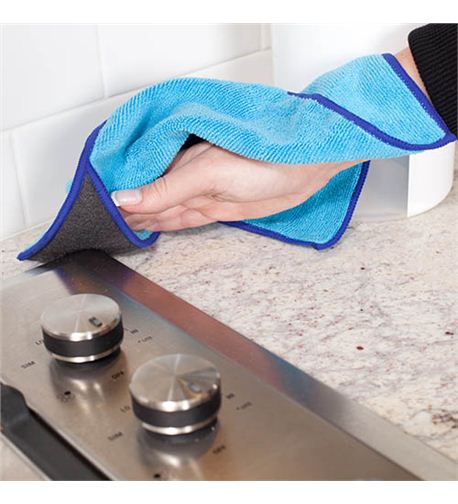
Separate When Washing
Always separate your dirtiest towels, like those used to clean dirt or for polishing such as stainless steel polishes and wood polishes, from your ‘good’ plush and drying towels to avoid cross contamination and wash them in separate loads. Keep cotton and other materials out of the wash loads. Wash microfiber towels as it’own load.
What cleaning agent should I use?
Use a mild detergent like Tide Free And Clear or any dye free/perfume free liquid laundry soap – no powders or granulated.
Washer Setting
Set washer to a warm water setting. Some heat is required to break down waxes and polishes. Cold settings will not clean towels as effectively.If your washer is equipped with an extra rinse cycle, use it. This will make sure as much of the contamination and remaining soap is removed from the towels as possible.
Drying Microfiber
Microfiber can be machine dried if you prefer, use a low heat setting and NO FABRIC SOFTENER. Air or line drying is also an option, be sure to do this somewhere the towels cannot be contaminated with dust or lint.
Heavy stains, dirty jobs
No matter what there is going to be occasions where a towel becomes extremely contaminated or stained from either something you removed (grease, oil, etc) or it becomes dirty with dust, dirt and grime. In these situations pre-treating or at the very minimum pre-soaking the microfiber to keep these stains from setting in is key. Obviously, you can’t stop mid-job to clean your microfiber towels, so here are some quick tips to help with heavier contamination on the fly.
Pre-treat any towel that becomes heavily soiled. Spray liberally with degreaser. (this is THE BEST degreaser ever)Soak the heaviest contamination in degreaser diluted with water and rub the towel against itself to agitate, then set aside for the next step of cleaning.
Pre-soak towels to help start the cleaning process long before you get around to laundering them. Prep a separate bucket with VERY HOT clean water and add blue dawn dish soap along with gentle tide. Add towels. Soak towels for roughly 2 hours. If a towel ever becomes so contaminated that it doesn’t wash clean, it may be time to retire it to a new job. Rotate towels that have been heavily stained to less delicate tasks.
Wash/Dry
After that, I load the towels in my washing machine, heavy soil, extra rinse with the warm water setting. (Remember mild detergent only) NO fabric softner or anything scented…although sometimes I add 20 drops of peppermint and spearmint EO to keep my washer fresh.
After they finish washing, I dry them on for 80 minutes on medium heat. DO NOT use dryer sheets
**If a towel ever becomes so contaminated that it doesn’t wash clean, it may be time to retire it to a new job. Rotate towels that have been heavily stained to “project towels.”
Storing Towels
Where your towels are kept when they are not in use is just as important as how they are cared for, so make sure you have a solution for keeping your towels out of harms way and dust free between uses. Medium-sized plastic storage totes are an inexpensive solution – the lid will prevent towels from collecting dust(or lint), I made a spot in the laundry room for mine.
Boiling the contamination
In any event, if your towels begin to loose their performance or just don’t feel as good as they did new… boiling is the solution, the last resort, to bring them back. NOTE: this process applies only to towels
Fill a large cooking pot approximately 2/3rd full of water and bring to a boil
- Add approximately 1-2oz of distilled white vinegar per gallon of water and stir
- Place a few of the towels to be treated into the pot, maintaining a slow boil
- Stir continuously with a large spoon, avoid letting the towels rest against the bottom or sides for too long
- After about 60-90 seconds in the boil, remove the towels using tongs and rinse under cool water
- Wash using the “Regular Cleaning” guidelines outlined earlier and they should be as good as new.
NOTE: Should boiling fail to bring absorbancy to a towel or the towel continues to lint then you are most likely dealing with a towel at the end of its lifespan. Retire the towel to less important tasks and replace with a new one for future use.
How long will your towels last?
There really is no set answer to that question. Depending on how frequently they are used, how well they are cared for, and the types of products they’re used with a towel can last for a very short or very long time. On average a towel should last the average user at least a year or two. Understand that no towels are good forever, they wear out eventually like any other product that sees frequent use.
If you experience diminished performance after some time and tried the recommended boiling method it might be time to retire that towel and replace it with a new one. Microfiber towels are by far the best thing to clean with and it is very important to properly care for them.
Benefits of cleaning with Microfiber
Want to understand more about why cleaning with microfiber is so wonderful?! Check out these 4 important benefits of cleaning with microfiber towels.
Get cleaning done, the right way! 🙂

0 comments